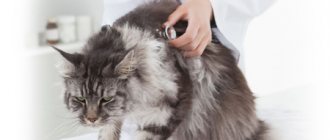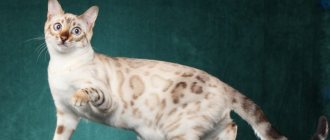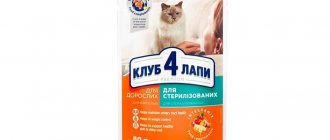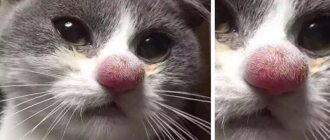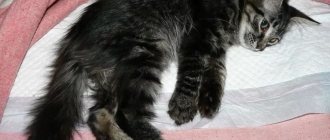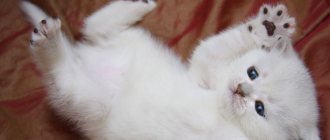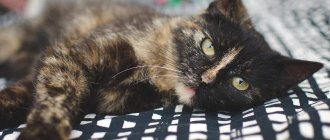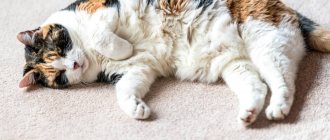- home
- Symptoms
- Edema in cats
What is edema, how and why it can manifest itself in a cat, and what to do about it, we will try to tell you in this article. So, edema is the accumulation of fluid in the intercellular space. Edema develops against the background of changes in vascular permeability and changes in osmotic pressure in the blood and tissues. Edema can be local and involve a certain area of the body, for example, a paw, muzzle, or a certain area of skin and subcutaneous tissue. Or it can be generalized, and then fluid accumulates throughout the interstitial (intercellular) space and body cavities. With generalized edema, the distribution of this fluid is usually uneven; for example, the edema is more pronounced on the side on which the animal lies for a long time, or on the limbs.
Blockage and inflammation of the sebaceous glands
This problem is often encountered by older animals and cats with metabolic disorders. Inflammation of the sebaceous glands is called acne. In essence, this is a violation of the release of sebaceous secretions, as a result of which the glands become clogged and inflamed.
Localization zones are the chin and the area around the mouth. The disease manifests itself as large black dots. If there are a lot of them, the epidermis in the affected area swells and turns red. If a cat's face is swollen and such spots are noticeable, it is necessary to begin treatment immediately.
It is recommended to first examine the animal to rule out hormonal changes, metabolic disorders and endocrine diseases, which can lead to malfunction of the endocrine glands. The exact acne treatment regimen depends on the severity of the symptoms. For moderate blockage of the sebaceous gland ducts, regular cleansing of the affected area is sufficient. Over time, the sebum will find its way out, the glands will cleanse and the swelling will subside.
If there are a large number of such blackheads, it is necessary to use antiseptics. As a rule, cats are prescribed chlorhexidine or miramistin. Treatment is carried out up to three times a day using a cotton pad soaked in an antiseptic.
It is important to understand that acne in cats is not just a cosmetic problem. The disease can lead to thinning of the coat in the affected area and the addition of a secondary infection, fungal or bacterial. In the first case, severe peeling and itching appears, in the second case, large purulent pimples appear, which cause severe discomfort to the pet.
What is edema?
Fluid retention in animal tissues occurs for various reasons.
There are two mechanisms for fluid accumulation:
- hydrostatic, associated with increased pressure in small vessels;
- hypoprotemic, associated with a violation of the protein content in the liquid part of the blood (plasma).
In the latter case, the permeability of small vessels increases due to inflammation, disorders of nervous regulation or toxic lesions.
The fluid that accumulates in the tissues can also be different:
- blood;
- lymph;
- pus.
Edema may vary in area and symmetry:
- they are limited (localized) and generalized (general);
- symmetrical and asymmetrical (for example, only one paw swells).
Limited swelling affects a small area of the body or organ. General ones cover large areas and indicate serious illnesses and a poor prognosis for the life of the animal.
Edema is caused by a condition called pre-edema. Predotec describes the state of preliminary accumulation of fluid in organs or tissues.
Allergic reactions
If a cat's face is swollen after changing its usual diet, the reason lies in an allergic reaction. Food allergies in pets occur primarily when feeding dry or canned food. Changing food from the usual manufacturer, introducing vitamin supplements into the diet, or simultaneously feeding natural and dry food - all this is fraught with the development of allergies.
Food allergies in cats often manifest as swelling on the face, mainly in the area around the mouth. This is accompanied by itching, so the cat may scratch the affected area until there are large wounds. In addition to the muzzle, swelling of the ears, redness of the ears, and discharge from the eyes and nose are noted.
To treat allergies in animals, the irritant must be identified. If symptoms appear after changing the diet, the pet should be transferred either to its usual diet or to a hypoallergenic diet. As a rule, swelling subsides within 1-2 days after the irritant is eliminated.
The same reaction may occur in response to certain medications, in particular flea drops, household chemicals, or animal bathing shampoos. Allergy symptoms appear quickly, within a maximum of two hours. Having noticed alarming signs, the owner should analyze recent events and identify a potential irritant. If it is household chemicals or “cat” shampoo, the fur should be thoroughly rinsed with water to eliminate the smallest particles of the allergen that may remain on the skin.
Rhinotracheitis, calcivirosis and other upper respiratory tract infections
Feline upper respiratory tract infection is a general term for respiratory infections caused by one or more viral or bacterial agents.
The infection may be caused by one or more viral and/or bacterial agents. The most common viruses that cause upper respiratory tract infections in cats are:
- Herpesvirus type 1 is also known as feline rhinotracheitis virus or FVR.
- Calcivirosis (FCV).
The most common bacteria that cause upper respiratory tract infections in cats are:
- Bordetella bronchiseptica.
- Chlamydophila felis.
Rhinotracheitis and calcivirus cause approximately 90% of all secondary respiratory tract infections in cats. Other, less common pathogens that can lead to purulent discharge and inflammation of the nose are:
- Mycoplasmosis.
- Rotavirus.
Dental diseases
A swollen face in a pet can be caused by dental problems. If the cat's face is swollen, and an allergy is definitely excluded, it is necessary to carefully examine the oral cavity. Broken teeth can irritate the tissue around them, potentially causing swelling. Swelling of the gums, in turn, leads to pronounced swelling of the lower or upper jaw, depending on the location of the broken tooth.
Another reason is gumboil or purulent abscess of the gums. This pathology is manifested by a bacterial infection that has entered the soft tissue of the mucosa. As a result, an abscess forms in the affected area - a large cavity filled with pus. A large abscess is visible to the naked eye, as one side of the cat’s face swells.
The disease is dangerous because the infection spreads throughout the body through the bloodstream. It can only be treated surgically. The operation consists of removing the damaged tooth and cleaning the cavity from purulent exudate. After opening the abscess, treatment continues with antibacterial agents at home.
Oral cancer as a reason for swollen faces in cats
Oral cancer accounts for 3% of all cancers in cats. Cats aged 11-12 years are most often affected, but cases of the disease have also been reported in younger cats. The most common types of oral cancer in cats are squamous cell carcinoma (70%) and fibrosarcoma (20%); much less common are lymphoma, malignant melanoma, osteosarcoma, chondrosarcoma, fibrosarcoma, hemangiosarcoma and ameloblastoma.
Squamous cell carcinoma of the tongue often spreads to surrounding tissue and bone. The main symptoms are swelling of the mouth, difficulty breathing, problems with chewing and swallowing, and excessive discharge from the mouth (drooling). Squamous cell carcinoma has a dangerous rate of spread/invasion into surrounding tissue, so early diagnosis offers the best prospects for treatment. Treatment depends on the location of the cancer; surgical removal of the tumor followed by chemotherapy and radiotherapy may be recommended. Tumors of the oral cavity in cats rarely (in less than 10% of cases) give hematogenous metastases to the lungs, with a tendency to locally destructive growth, recurrence and metastasis to regional lymph nodes. Life expectancy for oral cancer depends on the histological type and location of the tumor, as well as the stage of tumor development.
Factors that cause oral cancer in cats include the use of canned food in the cat's diet and smoking by the owner. For example, cats whose diet consists of more than 50% canned food have an increased risk of developing squamous cell carcinoma and thyroid adenocarcinoma. Nicotine metabolites were found in higher concentrations in the urine of cats whose owners smoked than in the urine of passive smokers. The fact is that the surface area of an animal's fur is many times greater than the surface area of its body, which contributes to the accumulation of tobacco smoke in the fur in a much higher concentration than if the animal were without hair. The concentration of nicotine metabolites in the urine of domestic cats whose owners smoke more than 20 cigarettes per day is comparable to the concentration in a human smoker.
Lymphadenitis
When the lymph nodes (submandibular, axillary) are inflamed, the inflamed tissues swell greatly, the area of edema is very painful on palpation. When the submandibular lymph nodes are inflamed, the animal cannot chew (the process is very painful).
Swelling after sterilization
Postoperative swelling is not uncommon. Swelling and redness may be observed in the scar area. This occurs due to swelling of the internal sutures. No treatment is required; after the internal sutures are absorbed, this swelling goes away on its own.
Prevention
Walking your cat on a leash will help you avoid unnecessary injuries or fights with other animals.
To reduce the likelihood of facial swelling in cats, veterinarians recommend that owners carefully monitor their pets. It is better not to let them go outside alone, which will protect the animals from fights, injuries and bites. Walking without an owner is most dangerous for cats that are over 3 months old. Their fear has already disappeared, but the kittens have not yet fully grown up to adequately assess the threats and fight back the offender. It is important for cat owners to remember that industrial complementary foods sold in stores can cause allergic reactions. If a decision has been made to diversify your pet’s diet with a new food, it is recommended to introduce it gradually, observing the response of the animal’s body. An important preventive measure is a systematic examination of the cat, its ears, eyes, nose and mouth. You should attend routine medical examinations with your pet at a veterinary clinic, which will help identify the development of pathologies at the initial stages.
Snake bite
Cats also often become victims of snake bites. Of course, this is not typical for pets living in an apartment and not going outside. But for cats who live in the house or come to the country in the warm season - it’s fine.
Of course, the greatest danger comes from the bites of poisonous reptiles. This may well lead to shock and even death of the animal. However, even the bite of non-venomous snakes poses a certain threat. Primarily due to the fact that during a bite a wound is formed, into which infection from the snake’s teeth enters. Because of this, a focus of inflammation arises, which can lead to dire consequences.
To prevent this from happening, you need to use antibiotics. But there is no particular rush here - it is enough to take action in the next few hours.
But if you are bitten by a poisonous snake, you need to act as quickly as possible. Alas, not every home medicine cabinet has an antidote, so it is advisable to immediately visit a veterinarian. Along with the antidote, he may give an injection of diphenhydramine. After the shock has been relieved and the effects of the poison have been eliminated, the doctor may also prescribe broad-spectrum antibiotics to eliminate the possibility of inflammation.
Rinsing the nasal passages
If a pet cannot breathe normally, this may be due either to the fact that its nose is clogged with dried exudate, or due to swelling and swelling of the mucous membranes. In all these cases, we recommend rinsing the animal’s nose, as this contributes to its speedy recovery. The procedure is not without pitfalls, and therefore we recommend enlisting someone’s help. Rinsing a cat's nose is done as follows:
- The solutions used for washing must be heated to a temperature of approximately 37°C.
- Ideally, you should use the smallest syringe for flushing, but an insulin syringe works well for this purpose. We recommend connecting a tube from a catheter for intravenous injections to its spout. It is thin enough to be inserted into the animal's nostrils.
- After this, the pet must be carefully secured in a lying position. If for some reason you were unable to get an assistant, you can press the cat’s head between your knees.
- When the cat is securely secured, they begin to inject the rinsing solution first into one nostril, then into the other. You can fill no more than 0.5 ml at a time. After each serving, it is necessary to pause so that the pet has time to rest properly.
- At the end of the procedure, it is necessary, using a gauze pad soaked in warm saline, to clean the cat’s face from any remaining washing liquid and exudate.
Since the animal will probably not be in the best mood after rinsing the nose, medicinal drops or other medications must be instilled/applied immediately, without letting the pet go! Otherwise, there is no guarantee that he will be caught.
Solutions used for rinsing the nasal cavity
In most cases, ordinary saline solution can be used for rinsing. But it is still better to treat the nasal cavity with a 0.05% chlorhexidine solution. It is not much more expensive than saline solution, but it has anti-inflammatory and antibacterial effects.
You may be interested in: Redness and swelling with lymphostasis
In addition, when treating rhinitis and, accordingly, nasal congestion, there is often a need to relieve swelling of the mucous membranes (as discussed above). For this purpose, you can use a 1-1.5% solution of ordinary table salt.
But! In order for rinsing to be effective and really help restore the cat’s former ease of breathing, it should be done regularly and as often as possible. So, for purulent rhinitis, it is recommended to rinse the animal’s nose every one and a half to two hours, until the symptoms completely disappear. If you carry out the procedure a couple of times a day, there will be no effect from it!
Treatment
First aid depends on the cause of the swelling. If the swelling is caused by a blow or bruise, cold can be applied to the site of the bruise in the first day after the injury. The next day, the injury site needs to be warmed up.
If the swelling is cold, it is sometimes recommended to knead the animal’s limb to restore blood circulation. If blood flow is disrupted, this can bring relief to the pet, but in the case of thrombosis, massage can cause a blood clot to break off and embolism.
In case of “hot” swelling, it is recommended to apply cold compresses. This is acceptable for insect bites. But in the case of inflammatory processes, specific treatment with antibacterial agents is necessary.
If there is swelling, it is worth taking your pet to the veterinarian to find out the cause of the phenomenon and prescribe proper treatment.
